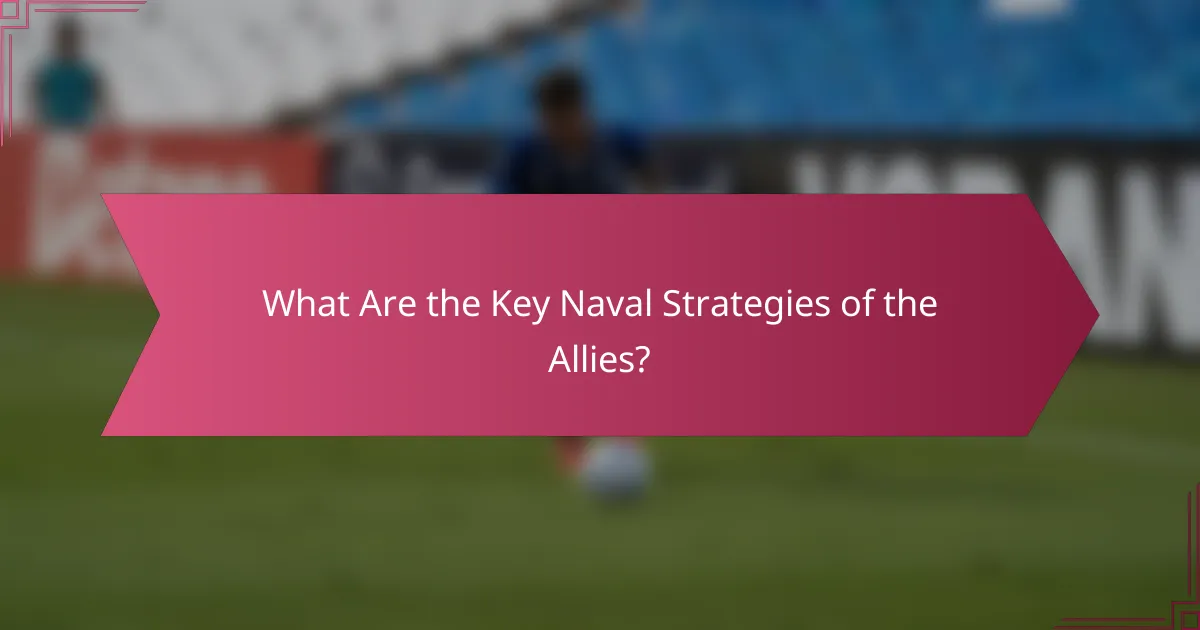During World War II, the naval strategies of the Allies and Axis powers showcased contrasting approaches to achieving maritime dominance. The Allies focused on combined operations and convoy systems to secure vital supply lines, while the Axis employed asymmetric warfare tactics aimed at disrupting these lines through submarine and surface fleet engagements. The effectiveness of these strategies ultimately played a crucial role in determining the outcomes of naval engagements and the overall success of the war.

What Are the Key Naval Strategies of the Allies?
The Allies employed several key naval strategies during World War II that significantly contributed to their success. These strategies included combined operations, convoy systems, submarine warfare, air-sea coordination, and island hopping campaigns, each designed to enhance their naval dominance and disrupt Axis supply lines.
Combined Operations
Combined operations involved coordinated efforts between different branches of the military, particularly the navy and army, to achieve strategic objectives. This approach allowed for the effective use of naval power to support ground forces, as seen in the D-Day landings in Normandy, where naval bombardments preceded troop landings.
Successful combined operations required meticulous planning and communication among the forces involved. Key considerations included timing, logistics, and the integration of air support to ensure that naval forces could effectively assist ground troops during assaults.
Convoy System
The convoy system was a strategy used to protect merchant ships transporting vital supplies across the Atlantic. By grouping ships together and providing them with naval escorts, the Allies aimed to minimize losses from German U-boat attacks.
This system proved effective, as it reduced the risk of individual ships being targeted. The use of destroyers and aircraft to patrol and protect these convoys was crucial, and the Allies adapted their tactics based on U-boat patterns, often employing zigzag routes to evade attacks.
Submarine Warfare
Allied submarine warfare focused on disrupting Axis supply lines and targeting enemy vessels. Submarines were used to attack merchant ships and warships, significantly impacting the Axis’s ability to transport goods and maintain naval strength.
Effective submarine operations required stealth and strategic positioning. The Allies employed tactics such as wolf packs, where multiple submarines would coordinate attacks on a single target, maximizing their chances of success while minimizing exposure to enemy defenses.
Air-Sea Coordination
Air-sea coordination involved the integration of naval and air forces to enhance operational effectiveness. This strategy allowed for air support to provide reconnaissance, strike capabilities, and protection for naval vessels during operations.
Successful coordination required clear communication and joint training exercises. The Allies utilized aircraft carriers to launch air strikes against enemy ships and installations, significantly increasing their operational reach and effectiveness in naval engagements.
Island Hopping Campaign
The island hopping campaign was a strategy aimed at capturing key islands in the Pacific while bypassing heavily fortified positions. This approach allowed the Allies to establish bases closer to Japan and cut off supply routes without engaging in costly battles at every stronghold.
Key considerations included selecting islands that offered strategic advantages, such as airfields and ports. The campaign required careful planning and logistics to ensure that forces could be supplied and reinforced effectively as they advanced through the Pacific theater.

How Did Axis Naval Strategies Differ?
Axis naval strategies primarily focused on disrupting Allied supply lines and establishing dominance at sea through asymmetric warfare. This approach included the use of submarines, surface fleets, and strategic raids, each with distinct tactical objectives and outcomes.
U-Boat Campaign
The U-Boat campaign was a cornerstone of Axis naval strategy, aiming to cut off supplies to Britain and other Allies through submarine warfare. German U-boats targeted merchant vessels in the Atlantic, employing stealth and surprise to maximize damage.
This campaign saw varying degrees of success, particularly during the early years of the war when U-boats operated in wolf packs. However, advancements in Allied anti-submarine technology and tactics eventually diminished their effectiveness.
Surface Fleet Engagement
Surface fleet engagement involved direct naval battles between the Axis and Allied fleets, with the German Kriegsmarine attempting to challenge British naval supremacy. Key battles, such as the Battle of the Atlantic, showcased the importance of battleships and cruisers in asserting control over sea lanes.
While the Axis had formidable ships, such as the Bismarck, their impact was limited by strategic miscalculations and the Allies’ ability to concentrate forces. The focus on surface engagements often diverted resources from more effective submarine operations.
Naval Blockades
Naval blockades were employed by the Allies to restrict Axis access to vital resources, significantly impacting their war efforts. The Axis, particularly Germany, attempted to counter this through their own blockades, targeting enemy supply routes.
However, the effectiveness of these blockades varied. The Allies’ superior industrial capacity allowed them to sustain their forces despite blockades, while Axis economies struggled under the weight of sustained Allied pressure.
Strategic Raids
Strategic raids were conducted by the Axis to disrupt Allied operations and morale, targeting ports and supply depots. These raids aimed to create confusion and weaken the enemy’s logistical capabilities.
Notable examples include the raid on the British port of Scarborough and the attack on the Soviet Union’s Baltic Sea supply lines. While these raids occasionally achieved tactical victories, they often failed to produce lasting strategic advantages, as the Allies adapted quickly to counter such threats.

What Were the Outcomes of Allied Naval Strategies?
The outcomes of Allied naval strategies during World War II were pivotal in securing victory over the Axis powers. Key achievements included the control of vital sea lanes, the defeat of enemy naval forces, and the protection of crucial supply lines.
Control of Sea Lanes
The Allies effectively established control over major sea lanes, which was essential for maintaining trade and military logistics. By securing these routes, they ensured the uninterrupted movement of troops and supplies, significantly impacting the war’s progress.
Naval operations, such as the Battle of the Atlantic, showcased the importance of controlling these lanes. The Allies employed advanced tactics, including convoy systems and anti-submarine warfare, to protect merchant ships from Axis attacks.
Defeat of Axis Powers
The defeat of Axis naval forces was a direct result of the Allies’ strategic planning and execution. Key battles, such as the Battle of Midway and the Battle of Leyte Gulf, demonstrated the effectiveness of Allied tactics in crippling enemy fleets.
By leveraging superior technology, intelligence, and coordination, the Allies were able to turn the tide against the Axis. This not only diminished the enemy’s naval capabilities but also boosted Allied morale and support for the war effort.
Protection of Supply Lines
Protecting supply lines was crucial for sustaining military operations and ensuring that troops received necessary resources. The Allies implemented various strategies, including escort missions and air cover, to safeguard these vital routes.
For instance, the use of aircraft carriers allowed the Allies to project air power over the ocean, providing protection for convoys against enemy submarines and surface ships. This proactive approach helped maintain the flow of supplies, which was essential for the success of Allied campaigns across multiple theaters of war.

What Were the Outcomes of Axis Naval Strategies?
The outcomes of Axis naval strategies during World War II were mixed, characterized by initial victories followed by significant setbacks. While the Axis powers achieved early successes, their long-term effectiveness was hampered by resource limitations and strategic failures.
Initial Successes
At the onset of World War II, Axis naval strategies, particularly those of Germany and Italy, yielded notable victories. The German U-boat campaign effectively disrupted Allied shipping, leading to significant losses in merchant vessels. Similarly, Italy’s naval engagements in the Mediterranean initially showcased their capabilities, allowing them to control key maritime routes.
These early successes were marked by innovative tactics, such as the use of wolf pack formations by U-boats, which exploited the vulnerabilities of Allied convoys. This period saw the Axis powers gain confidence in their naval operations, setting the stage for further confrontations.
Resource Limitations
Despite initial victories, Axis naval strategies faced severe resource limitations that ultimately undermined their effectiveness. Germany, for instance, struggled with a shortage of fuel and materials needed for shipbuilding and maintenance. This scarcity hampered their ability to sustain prolonged naval engagements.
Italy similarly encountered challenges in maintaining a robust naval fleet due to limited industrial capacity and logistical support. These resource constraints restricted their operational reach and effectiveness, leading to a gradual decline in naval power as the war progressed.
Strategic Failures
Strategic failures significantly impacted the Axis naval efforts, leading to their eventual decline. One major miscalculation was the underestimation of Allied naval capabilities and coordination, particularly in the Atlantic and Mediterranean theaters. The Allies adapted quickly, implementing effective countermeasures against U-boat threats.
Additionally, the Axis powers failed to establish a cohesive naval strategy that integrated their forces effectively. This lack of coordination resulted in missed opportunities and weakened their overall naval presence. The combination of these strategic missteps contributed to the eventual dominance of Allied naval forces.
